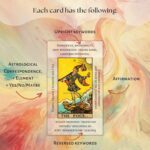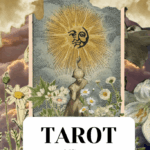The Moon reversed tarot card presents a rich tapestry of meanings and interpretations, especially when considered through a Christian lens. This intricate interplay of symbolism invites introspection and reflection, urging believers to delve deeper into their spiritual journeys. Understanding this card’s significance can illuminate the often murky waters of uncertainty that accompany faith and the human experience.
To navigate the profound symbolism of the Moon reversed, one must first grasp its essence as it pertains to intuition and subconscious awareness. It embodies the duality of light and shadow, a depiction of the divine illumination that can either guide or obscure our path. In the Christian faith, there is a tradition of using metaphors of light and darkness. The Moon, in its shadowy phase, serves as a poignant reminder of the moments when clarity is shrouded in doubt, paralleling the trials of faith that many believers experience.
In its upright position, the Moon often signifies confusion, illusion, and misinterpretation. However, when reversed, these attributes take on a nuanced meaning, suggesting the potential for clarity and revelation. The act of flipping the card symbolizes a shift—a transformative moment when darkness recedes, and the light of understanding dawns. For Christians, this can manifest as a renewal of faith. In moments of trial, when doubt prevails, the reversed Moon offers a sacred assurance that one may emerge from confusion into a realm of enlightened discernment.
Furthermore, within Christian doctrine, the revelation of truth is often tied to divine timing. The Moon reversed can signify that the answers sought in times of distress may soon unfurl themselves like a flower blossoming in spring. This foreshadowing urges believers to remain steadfast in their spiritual walk, as trials are often precursors to profound insights and divine encounters. It encourages an openness to receiving heavenly guidance, akin to being awakened from a dream, where clarity pierces through previous misconceptions.
The pervasive themes of anxiety and fear, often associated with the upright Moon, are also reversed in this interpretation. The Moon reversed invites believers to confront their fears, allowing for an unsettling yet transformative process. It challenges individuals to examine why fear exists as a barrier to spiritual growth. Through introspection, there may emerge an understanding that fear can be confronted and overcome, much like Jesus instructing His followers to cast their burdens upon Him. The implication is inviting—in the act of releasing fears, one can rediscover peace and serenity inherent in faith.
The implications of moving past uncertainty are significant. As the reversed Moon appears within a reading, it may highlight the necessity of navigating through a phase of disillusionment to reach a more holistic understanding of one’s spiritual journey. Just as the biblical narrative recounts moments of doubt—think of the struggles faced by David or Moses—so too does the reversed Moon imply that such moments are part and parcel of ascending in faith. Recognizing that doubt can be a fertile ground for growth is essential for every believer grappling with their spiritual identity.
Moreover, the reversed Moon serves as a solemn reminder to scrutinize intuition versus delusion. With a focus on the importance of discernment, believers are encouraged to discern between genuine spiritual callings and misleading impulses that may arise in periods of insecurity. This theme of discernment is critical in Christianity, where individuals are continually urged to seek the counsel of God and test their spirit against the truth of Scripture. The reversed Moon, thus, can be perceived as an exhortation to develop a sharpened sense of awareness, aligning one’s personal insights with divine guidance.
As believers grapple with the meanings of the Moon reversed, intrinsic curiosity is often piqued. This invites exploration into not only personal beliefs but also the collective understanding of faith narratives. The card evokes an inquiry into systemic beliefs, traditions, and the depth of relationships with the divine. It encourages questions about the nature of God’s presence in moments of uncertainty. Does God truly abandon His followers in darkness? Drawing from scriptural accounts, the answer is a resounding no. Thus, the reversed Moon may serve as a call to dialogue with God—casting away insecurities while seeking clarity in prayer and meditation.
Another dimension of the reversed Moon is its potential to symbolize healing. Just as the moonlight has been regarded as soothing and gentle, a reversed reading may indicate that healing from past traumas or spiritual wounds is possible. This is akin to the Christian belief in redemption and renewal. The act of surrendering pain and accepting divine healing fosters an atmosphere of hope—a fundamental pillar in Christianity. The transformation from anguish to tranquility mirrors the lunar cycle itself—darkness gives way to light, illustrating that healing and growth often emerge from painful experiences.
In conclusion, the Moon reversed embodies a myriad of meanings, interwoven with themes of revelation, healing, decision-making, and spiritual awakening. For Christians traversing the winding paths of faith, it beckons one to embrace uncertainty as a precursor to enlightenment. As shadows give way to understanding, believers are prompted to cultivate resilience, surrender fear, and unveil the divine truths hidden beneath the surface of their subconscious. The journey with the Moon reversed, ultimately, is not merely a tarot reading but rather a call to a deeper exploration of faith, renewal, and the perpetual pursuit of spiritual clarity.









Leave a Comment